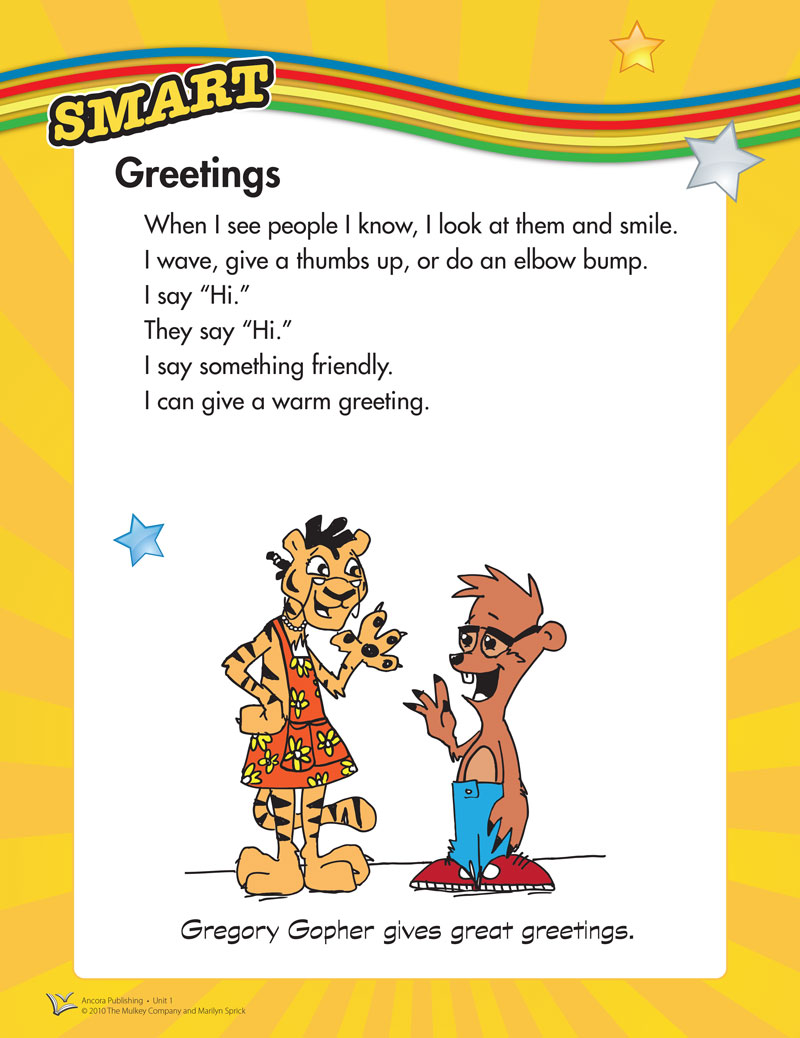A Circle of Support for Social Emotional Learning, Behavior Supports, and Literacy Wellness
As educators, we have the noble task of helping children prepare for productive and self-fulfilled adult lives. Social emotional learning (SEL), positive behavior support, and literacy wellness all contribute toward that end. When we weave our teaching and learning from each domain, the related skills buoy and enhance each other. Read on for specific teaching examples for students of all ages.
Setting For Young Children: Small-Group Reading
Literacy Learning. Ensure all of your students become readers by using a curriculum that includes systematic and explicit instruction in phonemic awareness, phonics, fluency, and comprehension. Use small-group instruction combined with progress monitoring to ensure all students receive the intensity of instruction needed to read well.
SEL. When students arrive for small-group instruction, periodically use a quick social story to welcome them. Model and guide a warm greeting with students, then jump right into a motivating lesson.

Positive Behavior Supports. Use positive descriptive feedback during your lessons. Tell students exactly what they did right. When doing sound practice, say things like, “Wow, you read that accurately and with speed. That was easy peasy!” When reading connected text, say things like, “You sounded frightened when you read, ‘It hit me with a smack!’ You sounded just like Chicken Little.”
Setting For Young Children: Small-Group Reading
Literacy Learning. Ensure all of your students have the opportunity to become competent readers. Use universal-screening procedures to determine who needs intervention. Provide intensive small-group or one-to-one tutoring in a curriculum that builds decoding skills, provides fluency building activities, and routinely uses comprehension-building activities—including content knowledge and vocabulary knowledge.
Positive Behavior Supports. During reading lessons, teach guidelines for success, such as perseverance, integrity, teamwork, and professionalism. Explicitly teach rules that help students demonstrate those traits. For example, to support the broad concept of teamwork, have students learn to compliment each other on their work. After listening to a partner read, students can give compliments such as, “Your reading was really smooth and expressive.”

SEL. To help students learn self-management of behaviors that will help them achieve long-term goals of employability and reading competence, have students self-evaluate at the end of literacy lessons. For example, lessons can end with something like, “Did you persevere? If yes, put one finger up. Jasmine, you did persevere. You were focused on each task. If I were your employer, I would give you a raise.” Over time, students learn to think of their own actions and how their behaviors support the guidelines for success.
The Circle
Literacy learning, SEL, and behavior supports work in tandem as students engage in productive reading lessons at Tiers 1, 2, and 3. Teaching well is a complex task. The more tools we have as educators, the greater our ability to weave together strategies that propel all of our students toward greater competence and independence in reading. The resource list below provides pragmatic tools and easy-to-reference research guides that may help you weave SEL and positive behavior supports seamlessly into your research-based literacy instruction.
I’ll be speaking more about this topic during a webinar called, “Integrate Literacy, Behavior, and Social Emotional Learning: Strategies for Educators.” I’ve shared additional strategies and tips, so I hope you’ll join me.
RESOURCES
PRIMARY READING INSTRUCTION
International Dyslexia Association®. (2019). Structured literacy: An introductory guide. Author.
National Reading Panel. (2000). Teaching children to read: An evidence-based assessment of the scientific research literature on reading and its implications for reading instruction. National Institutes of Health.
ADOLESCENT READING
Kamil, M. L., Borman, G. D., Dole, J., Kral, C. C., Salinger, T., & Torgesen, J. (2008). Improving adolescent literacy: Effective classroom and intervention practices: A practice guide (NCEE #2008-4027). National Center for Education Evaluation and Regional Assistance, Institute of Education Sciences, U.S. Department of Education.
Vaughn, S., Gersten, R., Dimino, J., Taylor, M. J., Newman-Gonchar, R., Krowka, S., Kieffer, M. J., McKeown, M., Reed, D., Sanchez, M., St. Martin, K., Wexler, J., Morgan, S., Yañez, A., & Jayanthi, M. (2022). Providing reading interventions for students in grades 4-9 (WWC 2022007). National Center for Education Evaluation and Regional Assistance (NCEE), Institute of Education Sciences, U.S. Department of Education. Retrieved from https://whatworks.ed.gov/.
BEHAVIOR SUPPORTS AND SEL
Mulkey, S., & Sprick, M. (2010). SMART Kids, A Safe and Civil Schools skills curriculum. Ancora Publishing.
Sprick., J, Sprick, R., Edwards, J., & Coughlin, C. (2021). CHAMPS: A proactive & positive approach to classroom management (3rd ed.). Ancora Publishing.


